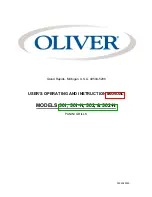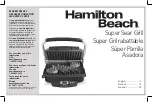
4
OPERATION
WARNING
To reduce the risk of injury, always
wear proper eye protection marked
to comply with ANSI Z87.1.
When working in dusty situations, wear appro-
priate respiratory protection or use a suitable
dust extraction solution.
WARNING
To reduce the risk of injury, hold
or brace securely. Always be pre-
pared for bit binding and drill reaction.
WARNING
To reduce the risk of injury, keep
hands away from the bit and all
moving parts.
Bit binding
If the bit binds, the drill will suddenly react in the
opposite direction of the rotation of the bit. Reduce
the chances of a sudden reaction by following the
instructions listed below. Prepare for a sudden reac-
tion by holding or bracing securely.
To reduce the chance of bit binding:
• Use sharp bits. Sharp bits are less likely to bind
when drilling.
• Use the proper bit for the job. There are many types
• Keep selfeed bits aligned with the work surface so
bits go in straight (see "Drilling").
• Avoid drilling warped, wet, knotty, and/or pitchy
material if possible.
• Avoid drilling in material that you suspect contains
hidden nails or other things that may cause the bit
to bind.
The direction of reaction is always opposite of the
direction of bit rotation. Reaction is even more likely
to occur when enlarging already existing holes and
at the point when the bit breaks through the other
side of the material.
If the bit does bind:
1. Release the trigger immediately.
2. Reverse the motor.
3. Remove the bit from the work and start again.
4.
a stalled bit. This will damage the drill.
Bracing for forward rotation
When drilling in forward, the bit will rotate in a clock-
wise direction. If the bit binds in the hole, the bit will
come to a sudden stop and drill will suddenly react
in a counterclockwise direction.
A
B
C
shows an example
of properly bracing
the tool for forward
rotation.
A. Forward (clock-
wise) rotation
B. Reaction
C. Brace drill with
motor housing
here
If the bit binds,
the motor housing
braced against the
stud will hold the drill in position.
ASSEMBLY
WARNING
Recharge only with the charger
-
manual supplied with your charger and battery.
Removing/Inserting the Battery
To
remove
the battery, push in the release buttons
and pull the battery pack away from the tool.
WARNING
Always remove battery pack before
changing or removing accessories.
To
insert
the battery, slide the pack into the body
of the tool. Make sure it latches securely into place.
WARNING
recommended for this tool. Others
may be hazardous.
Bit Selection
• Use sharp bits. Sharp bits are less likely to bind
when drilling.
• Use the proper bit for the job. There are many
the information on the bit's packaging for proper
usage.
• Do not use bits larger than the rated capacity of the
drill. Gear damage or motor overload may result
Installing Bits
Always remove the battery before inserting or remov-
ing bits. Select the proper style and size bit for the
application.
Installing Bits into Keyed Chucks
1. Remove the battery pack.
2. Open the chuck jaws wide
enough to insert the bit. Be
sure the bit shank and chuck
jaws are clean. Dirt particles
may prevent the bit from lining
up properly.
3. Insert the bit into the chuck.
Centre the bit in the chuck
Tighten the chuck jaws by hand to align the bit.
jaws and lift it about 1.6mm (1/16") off of the bottom.
4. Place the chuck key in each of the three holes in
the chuck, turning it clockwise to tighten the chuck
securely.
NOTE:
Never use a wrench or means other than
a chuck key to tighten or loosen the chuck.
FUNCTIONAL DESCRIPTION
1. Top handle
2. Control switch
3. Trigger
4. Main handle
5. Chuck key storage
6. LED
7. 13mm (1/2") Keyed chuck
5
1
7
4
3
6
2
5. To remove the bit, insert the chuck key into
one of the holes in the chuck and turn it counter-
clockwise.


























